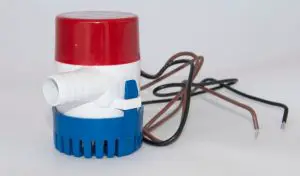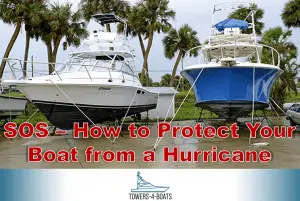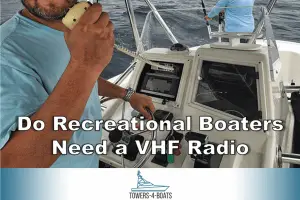Participants who want to slalom water ski requires them to be on one ski also known as slalom, this type of water skiing makes use of multiple buoys in its course, a skier must go around these buoys to complete the competition.
For avid water skiers, slalom water skiing is the ideal ski course that is both challenging and exhilarating. A complete slalom course consists of 26 individual buoys, and people may want to create their own slalom water ski courses, but may ask themselves, how to set up a slalom water ski course?
Step-by-Step Guide On How To Set Up a Slalom Water Ski Course
1 – Take or estimate measurements
The correct measurements for a slalom course are:
- Length: A typical slalom course is 850 feet (259 meters) long, but individuals can settle for 600 feet (180 meters) in length that approaches the space of both ends, but the most ideal size would be 2,000 feet (600 meters) in length.
- Width: A regular water ski slalom course that can be used for practice is 75 feet (23 meters) wide, and additional space up to 100 feet (30 meters) wide is welcomed for extra precautionary measures, making the minimum width of the course 275 feet (85 meters).
But remember that the course requires a lot more water areas, than the course itself (which are made up of the buoys), the water should be 5 feet (1.5 meters) deep, during the time of using the course.
2 – Get permission
Before starting the project, make sure to know what permission is needed from local government agencies.
Different states’ may require a permit or not when laying out the course in public waters, these permits are given out by the environmental departments in each state, and an additional approval of the area where the reservoir is located may also be needed.
3 – Setting up the buoys around the course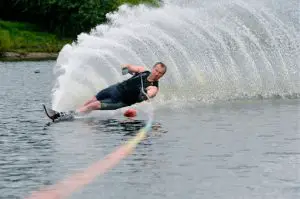
A slalom course makes use of 26 individual buoys, making it a multi-buoy course. In general, red buoys are used for the skier buoys and these red buoys are also used for the entrance gate and exit gate of the course. Yellow buoys are used for boat guide buoys, if the standard buoy is not available you may use other durable containers.
On reservoirs that have frequent water level variations, skiers are advised to attach a counterweight to each buoy to ensure the anchor line is intact.
4 – Anchoring the buoys
The most common anchoring method, is when individuals anchor a sub-buoy 3 feet below the surface of the reservoir and further attaching the surface buoys to these sub-buoys, elastic material may be used in keeping the anchor line taut and the buoys over the anchor. You may use several concrete building blocks as the anchor.
One block may also work for reservoirs that have a bottom area covered in mud, anchors made of poured concrete may also be used in anchoring buoys. To prevent chafing, you may use a garden hose that has a length of 2 inches (5 centimeters).
Sub-buoys are orange or white and can be easily distinguished when looking from the surface, and they are often used to find surface buoys that come off.
For warm weather installation, using the cut of a wooden square with the size of 2×5 is enough for this stage.
5 – Lining up the buoys
Line up 6 boat guide buoys, end gates should be wider than the entrance (2.5 meters to 2.3 meters), and then lay out 8 buoys, and since the end gate should be wider, adjust the width of it.
In creating the line up of buoys, anchor one buoy, indicating the start of the course and add in another buoy, placing it at the end of the course, helping you establish the line up of the whole course.
6 – Properly aligning and distancing the buoys
Now with the buoys in place, you may use it as the reference line, using the wooden square weather installation, you may now determine the proper distance between the boat guide buoys and skier buoys.
Using the short arm part of the material against the buoys, when you see that the square is perpendicularly aligned to the laid out buoys on the course, it is time to anchor the skier buoy at 10.35 meters mark to the boat guide buoy at the end.
Repeat the process for the remaining buoys.
That is the guide on how to lay out a slalom ski course, but individuals do not need to settle for makeshift materials since commercially available complete sets of cable slalom courses, making installment and creation of the course easier.
The Slalom Water Ski Course Dimensions
| Measurement | Distance (meters/feet) | Tolerance (cm/inches) |
|---|---|---|
| Entrance Gate to Boat Guides (length) | 27m / 88’6″ | 13.5cm / 5.25″ |
| Boat Guide to Boat Guide (length) | 41m / 134’6″ | 20.5cm / 8″ |
| Buoy to Buoy Diagonal | 47m / 154′ | 23.5cm / 9.24″ |
| Turn Buoy from Course Centerline | 11.5m / 37’8.4″ | 11.5cm / 4.5″ |
| Entrance Gate Width (buoy to buoy) | 2.5m / 8’2.4″ | 12.5cm / 5″ |
| Boat Guide Width (buoy to buoy) | 2.3m / 7’6″ | 23cm / 9″ |
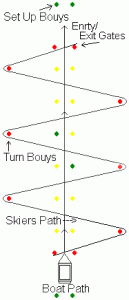
Length of the course
A slalom water ski course is longer, but in terms of width, it is not very wide. A buoy sits at 37.7 feet (11.5 meters) outside the centerline of the course, making the skier travel more down-course rather than side to side.
- An official and the most ideal measurement of the whole course should be 2,000 feet (600 meters in length.
- The minimum measurement for its length is 600 feet (180 meters).
- The average size of the course is 850 feet (259 meters).
Width of the course
It has been established that the slalom water ski course is longer than it is wide.
- The ideal width of the entire course is 275 feet (85 meters, which is also the minimum requirement.
- People can make use of an area that is 75 feet (23 meters) wide for practice.
- The addition of width space is always welcomed in the sport since it provides more safety measures, a measurement of up to 100 feet (30 meters) wide is acceptable.
Spacing between buoys
The line from buoy to buoy is longer than the gap between the different boat gates. The diagonal distance between individual buoys is 20 feet (6 meters).
The number of buoys
- In a professional course, the number of buoys required is 26.
- But individuals can settle for 22 when making a practice course.
The distance from the entrance gate to the boat guides
The average distance of the entrance gate of the course to the first set of boat guides is 88.5 feet (27 meters).
How Do You Do A Slalom Water Ski Course?
For slalom skiing, these are usually conducted in large open bodies of water or reservoirs, skiers usually ski back and forth across the wakes from side to side around the alternated buoys laid around the course.
While the boat drives to the middle of the course between the buoys, the slalom skier must smoothly ski around all laid buoys through a pattern of quick turns, acceleration, and deceleration when needed.
- Maintain a stable balanced stance on the slalom (ski) with your knees bent slightly to ski smoothly and rhythmically using a taut ski rope.
- Have the both go slower, for better control and comfort ensuring a smooth turn that will keep the rope taut, use a 60-foot rope for easier management.
- Practice rhythmically crossing the wake, remember that it is not a competition yet so skiing around every buoy is not necessary.
- To familiarize yourself with the course, make turns inside the buoys this process is called shadowing the buoys, giving you more flexibility while maintaining a rhythmic cadence from each buoy to the next.
- Once you familiarize yourself with the movement of traversing back and forth, to get from side to side more quickly, start pushing yourself.
- After rounding a buoy, make sure the ski is pointing to other end of the reservoir, perpendicular to the direction of the vehicle, creating an “angle” helping you accelerate the slalom across the wake fast.
- Repeat the process until successfully skiing around all buoys consistently.
When consistently practicing slalom water skiing, begin challenging yourself by asking the boat driver to increase their driving speed whilst you are skiing, small increases are recommended up to 2 mph. Over time, you may try and work up to a speed of 35 mph or more, which is the speed that pros use.
Related Questions
What Are The Slalom Water Ski Course Speeds?
In an official slalom water ski course, the speed reaches 36 mph (58 km/h). But the recommended speed for all water ski courses is 35 miles per hour.
How Do Slalom Skiers Know Which Gates?
These gates are color-coordinated and have a pair of flags or poles attached to the buoys to make it easier for slalom water skiers to race through the gates of various slalom courses.
- Red – the first gate is usually colored red, so the slalom skier should go between the red poles or flags to the next gate.
- Blue – the next indicator for these gates in the course is colored blue, which skiers need to go through after passing the initial red gate.
If the skier does not pass between the poles alternatively that makes up the gate in the course, they will be disqualified from the competition.

![You are currently viewing How to Set Up a Slalom Water Ski Course [Step-by-Step Guide]](https://towers4boats.com/wp-content/uploads/2020/10/How-to-Set-Up-a-Slalom-Water-Ski-Course.jpg)
